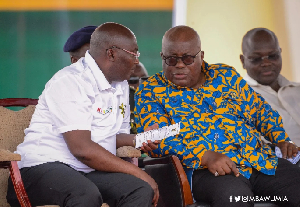Markets, credit and production bottlenecks remain the biggest concerns of non-traditional exporters, the B&FT has found -- in an era when commodities increasingly dominate Ghana’s international trade.
While non-traditional exports have been increasing, the three challenges continue to hinder the potential to diversify away from commodities, said Frederick Ayeh, vice-president of the Federation of Associations of Ghanaian Exporters (FAGE).
Gold, oil and cocoa beans accounted for 76 percent of exports between January-November 2011, according to data from the Central Bank, and together the three commodities boosted earnings to US$11.8billion.
“Either the market is available for a specific product, but production is not up to it ; or the product will be available but finance and credit is difficult to come by. We have to understand that commercial exporting is capital-intensive, and the inability to secure funds increases an exporter’s production costs and makes his product less competitive,” Ayeh said.
Non-traditional crop exports include banana, pineapples and vegetables, while cocoa products, plastics and plywood are among the top-earners.
“If an exporter operates with an obsolete machine, he will not be able to optimise his output; but to retool means funds or credit should be available.”
EDIF funds
Collateral required to access credit from the Export Development and Investment Fund (EDIF) effectively rules out start-ups from benefitting from the fund, Ayeh said.
EDIF money is given at 12.5 percent interest, cheaper than traditional borrowing rates of 30-40 percent interest. But according to him, the actual borrowing cost could scale-up to 17 percent on account of “processing fees”.
“Besides that, the funds are only for short-term projects; but our members need long-term funds.”
For instance, he said, pineapple farmers take 18 months to plant and harvest the crop, meaning a loan would have to cover at least the same number of months if the exporter is to pay back without hassle.
“But EDIF will not grant such a loan. And even if they did, the collateral, which should be equal to the value of the loan, makes it especially unattractive to start-ups,” he added.
EDIF is well-intended but not well-implemented, Ayeh lamented, as funding for agriculture, a key export sector, is generally a problem for commercial banks -- which put a risk-premium on loans to support the country’s rain-dependent crop production.
Demand and standards
Investment by donors and the government has improved quality-control for exports, and the ability to produce to standard is no longer a serious impediment to entering Western markets, he said.
A worry for the industry, though, is the impact of the slowdown in GDP and demand in the European Union -- the largest destination for non-traditional exports from Ghana, accounting for half of the total.
“We need to expand and look for new markets, especially in Africa, in order to stay competitive -- without throwing away our traditional partners,” Ayeh said.
The ECOWAS region is the second-largest market for non-traditional exports, and provided 26 percent of revenues in 2010.
According to two researchers, Kwabena Anaman of the Institute for Democratic Governance (IDEG) and Alhassan Atta-Quayson of Third World Network, hopes of reviving Ghana’s manufacturing sector hinge on fully tapping the demand potential in the sub-region.
“Poverty reduction in Ghana can be achieved through increased employment of people by the manufacturing sector. This entails increased export trade by Ghana within the West Africa region,” the two said in a study of the country’s bilateral trade relations with sub-regional economies.
Business News of Thursday, 16 February 2012
Source: BFT
Exporters bear frustrations

















